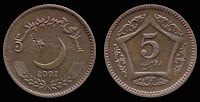A blog celebrating Pakistan’s journey through coins, stamps, and banknotes — from 1947 to today.


Thursday, December 31, 2015
Tuesday, December 29, 2015
Friday, December 25, 2015
Thursday, December 24, 2015
Wednesday, December 23, 2015
Tuesday, December 22, 2015
Friday, November 27, 2015
Pattern Coins
Pattern Coin is a coin which has not been approved for release, produced for the purpose of evaluating a proposed coin design. They are often off-metal strike, to proof standard or piedforts. They are collected or studied by many coin collectors because of their sometimes highly elaborate designs.
In Pakistan Mint’s history, they are consistently producing prototype or “pattern” coins to test various designs, metals, formats and techniques. Some examples of Pakistan Pattern Coins are
In Pakistan Mint’s history, they are consistently producing prototype or “pattern” coins to test various designs, metals, formats and techniques. Some examples of Pakistan Pattern Coins are
3 Paisa (1966) 1 Paisa Bronze (1967)
5 Paisa Aluminum (1971) 1 Rupee Nickel Brass (1991)
5 Paisa ND
10 Paisa ND 50 Paisa ND
1 Rupee Bronze (1995) 50 Rupees Bronze (1995)
5 Rupees Silver (1995) 5 Rupees Silver Double Strike
5 Rupees Pattern (1995) 5 Rupees Pattern (1995)
50 Rupees Pattern (1997) 50 Rupees Bronze (1997)
50 Rupees Pattern (1997)
25 Paisa Aluminum (1998) 50 Paisa Brass (1998)
5 Rupees Pattern (2001) 5 Rupees Pattern (2001)
5 Rupees Pattern (2001) 5 Rupees Pattern (2001)
5 Rupees Pattern (2001) 5 Rupees Pattern (2001)
5 Rupees Pattern (2001) 5 Rupees Pattern (2001)
5 Rupees Copper (2002) 5 Rupees Copper Zinc (2002)
10 Rupees Bronze (2003)
10 Rupees Bronze (2008) 10 Rupees Brass (2008)
Wednesday, November 25, 2015
Proof Coins - What are they ?
Uncirculated Coin
Uncirculated means a coin has not had any wear, such as the wear a coin might experience when it is used in commerce. Handling a coin, as well as improperly storing a coin, can result in wear on the surface of the coin. This wear, even if very minor, will cause a coin to no longer grade uncirculated.
When coins are minted they often bump into each other and receive small nicks and abrasion marks during the production process. These marks also occur as coins are transported in large canvas bags. These marks, sometimes called "bag marks", are more noticeable on larger coins.
An uncirculated coin may show tarnish, toning, spotting, or discoloration and still remain in uncirculated condition. Experts recommend you "never clean a tarnished coin", because most cleaning will cause wear on a coin, and thus lower its grade.
Proof Coin
Uncirculated means a coin has not had any wear, such as the wear a coin might experience when it is used in commerce. Handling a coin, as well as improperly storing a coin, can result in wear on the surface of the coin. This wear, even if very minor, will cause a coin to no longer grade uncirculated.
When coins are minted they often bump into each other and receive small nicks and abrasion marks during the production process. These marks also occur as coins are transported in large canvas bags. These marks, sometimes called "bag marks", are more noticeable on larger coins.
An uncirculated coin may show tarnish, toning, spotting, or discoloration and still remain in uncirculated condition. Experts recommend you "never clean a tarnished coin", because most cleaning will cause wear on a coin, and thus lower its grade.
A newly minted proof coin is also Un-circulated, however it
is the way it is made that causes a difference in appearance
and qualifies it as a "proof". To understand this,
let's look at how coins are made. Coins are produced
when two dies strike a blank piece of metal with tremendous
force. One die is engraved with the front (obverse) design
for the coin. The other die has the back (reverse)
coin design on it.
By
treating the die in a special way, the coins it produces
have a different appearance. Modern technology allows
the high points on the coin design to be acid treated (on
the die). The background (field) design of the coin
die is polished, resulting in a mirror-like look on the coin
it strikes. This gives the finished coin a frosted look
(frosting) on the raise parts of the design, with a mirror
like finish on the background. This contrasting finish is
often called "cameo".
Not only are proofs made using specially treated dies, each
coin is struck two or more times by the coin die. By
striking it more than once the metal is forced into all the
crevices of the die, thereby giving a very fine detail to
the image on the coin. This fine detail does not
appear on some non-proof coins.
Cameo Effect
The cameo effect on a proof coin is produced by the field having a mirror-like surface and the coin's devices having a frosted surface. If there is a dramatic contrast between the field and the devices, this is referred to as ultra/deep cameo.
The cameo effect on a proof coin is produced by the field having a mirror-like surface and the coin's devices having a frosted surface. If there is a dramatic contrast between the field and the devices, this is referred to as ultra/deep cameo.
Thursday, November 19, 2015
Banknote Posters on SBP website
Rs. 20 Banknote (English and Urdu Posters)
Rs. 50 Banknote (English and Urdu Posters)
Rs. 100 Banknote (English and Urdu Posters)
Rs. 500 Banknote (English and Urdu Posters)
Rs. 1000 Banknote (English and Urdu Posters)
Rs. 5000 Banknote (English and Urdu Posters)
Courtesy State Bank of Pakistan (www.sbp.org.pk)
Subscribe to:
Comments (Atom)

























































